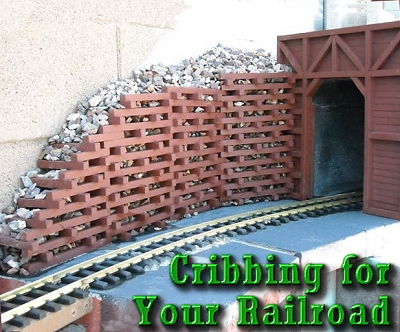 | |||
 |
 |  | |
 |
 | ||
 |  | ||
 |  | ||
 |  | ||
 | |||
 |
 |  | |
 |
 | ||
 |  | ||
 |  | ||
 |  | ||


|
CribbingUnlike cart-tracks and horse-trails, railroad rights-of-way must be as close to level as the terrain allows, and the curves must be wide, to enable the locomotive to pull most effectively. In mountainous regions, this means that hillsides are often cut away, leaving steep "walls" of stone and earth that can pose danger to the railroad, especially during freeze-thaw cycles. Engineers (not the kind that drive trains) use "cribbing" to stabilize such walls without resorting to a full-fledge retaining wall, which has its own maintenance issues. From the "outside," a cribbed wall usually looks like someone has arranged timbers in a "basket-weave" pattern. What you can't see is that for every two or three timbers that run lengthwise along the wall, there is one timber that goes deep into the wall to help "anchor" the other members in place. When Daryll Smith added a cribbing feature to his railroad and sent me some notes about it, I figured this was as good a time to present this content as any.Cribbing in the "Real World"In the 1800s, cribbing generally used the same sort of timbers the railroad was using for trestles. For small applications, railroad ties might be used. You can still occasionally see timber cribbing, especially in very dry climates. But today, cribbing may be made of other materials. The cribbing at the left below is made of reinforced concrete beams. It is near the Webster Street market, in Dayton, Ohio, in case you wanted. The cribbing at the right below is made of timbers that have been treated the same way railroad ties are treated, but these have never borne a rail. It is on the campus of Wayne State University, in Pennsylvania.
The Wayne State cribbing is unusual in that it doesn't have huge gaps between the cribbing material to allow for rushing water to pass through safely without taking the wall down with it (a potential problem with retaining walls). Of course all this cribbing is holding up is a tennis court or something like that, I think. But you can tell that there are timbers aimed inward. These inward-pointing timbers, called "deadman" pieces, are "anchored" in by the weight of earth and rocks upon them, like oversized stakes. When the builders fasten the more visible "sideways" timbers to the "deadman" pieces, the pressure from the earth or stone wall's surface doesn't keep inching the cribbing outward.
Model Railroad CribbingThat said, "cribbing" on most garden railroads is virtually cosmetic, holding back pounds of dirt instead of tons. Often you see a "latticework" or "basketweave" arrangement of tiny "beams" with no evidence that anything is really poking into the wall that the "cribbing" is ostensibly holding up. No problem, really. But I get especially interested when I see model railroad cribbing that looks to be constructed just like the real stuff. When Daryll sent me a bunch of photos that included his HDPE timber "cribbing," I knew this would be a pretty neat feature to include. The rest of this article really focuses on the cribbing that Daryll built to accompany the tunnel portal project he documented for us earlier. Daryll made the cribbing from "plastic" deck lumber cut into 1/2" x 1/2" pieces. The plastic deck lumber shows the saw blade swirls from ripping. This helps the beams look like rough-cut lumber from a saw mill, which the paint highlights. As you'll see eventually, Daryll needed 32" of cribbing so he constructed the walls in 8" sections. ConclusionDaryll has not only made a cosmetically impressive addition to his railroad; he has engineered it like the real thing. In the meantime, Daryll is moving so fast on his railroad, he will probably have more great photos to send by the time this page is posted, but I wanted you all to have a chance to see this in time to plan your mid-summer projects. If you have any comments or questions about any of Darryl's projects, please contact me and he will forward me your comments.
|


|

| 
|
 |
 |
 |
 |
 |
Note: Family Garden Trains?, Garden Train Store?, Big Christmas Trains?, BIG Indoor Trains?, and BIG Train Store? are trademarks of Breakthrough Communications (www.btcomm.com). All information, data, text, and illustrations on this web site are Copyright (c) 1999, 2000, 2001, 2002, 2003, 2004, 2005, 2006, 2007, 2008, 2009, 2010, 2011, 2012, 2013 by Paul D. Race. Reuse or republication without prior written permission is specifically
forbidden.
Family Garden Trains is a participant in the Amazon Services LLC Associates Program, an affiliate advertising program designed to provide a means for sites to earn advertising fees by advertising and linking to amazon.com.
For more information, please contact us

 |  |